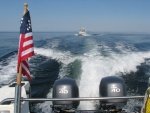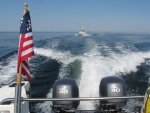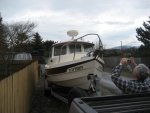You are using an out of date browser. It may not display this or other websites correctly.
You should upgrade or use an alternative browser.
You should upgrade or use an alternative browser.
Acoustics
- Thread starter Surveyor1
- Start date
srbaum
Member
I think the primary advantage to the ceiling tiles would be condensation abatement, rather than noise control.
In my 22, the primary noise sources are the motor and the water against the hull. Closing the cabin door helps a lot with the engine noise. Tiles on the ceiling won't help much with the hull noise. Eventually you be able to tell when the hull is riding nicely by the sound of the water rushing along the hull.
If you are concerned about ambient noise passing through the hull when sleeping, I find that a white noise generator hooked into the sound system works great for times when we are not using the AC or a fan.
In my 22, the primary noise sources are the motor and the water against the hull. Closing the cabin door helps a lot with the engine noise. Tiles on the ceiling won't help much with the hull noise. Eventually you be able to tell when the hull is riding nicely by the sound of the water rushing along the hull.
If you are concerned about ambient noise passing through the hull when sleeping, I find that a white noise generator hooked into the sound system works great for times when we are not using the AC or a fan.
Marco Flamingo
Active member
Simple fix: https://www.amazon.com/Macks-Ultra-Soft ... B0051U7W32
I have noise cancelling headphones if I want to listen to music.
It if is engine noise, the outboard cover can be soundproofed.
http://www.c-brats.com/modules.php?set_ ... _photo.php
I have noise cancelling headphones if I want to listen to music.
It if is engine noise, the outboard cover can be soundproofed.
http://www.c-brats.com/modules.php?set_ ... _photo.php
Chester":1qp3xinq said:I'd look into acoustic paint too.
Has anyone try one of those acoustic or insulating paint? I would like to have feedback and/or recommendation. In my case it would be mostly for insulation as a way to diminish condensation during shoulder saison (read cold and wet Alaska spring and fall saison).
I'm interested in trying HyTech microsphere ceramic paint additive, anybody already try this product?
Thanks
I did the inside of my boat with Hy-tech SC#1000. It is supposed to be a "sound control coating". I applied it based on a posting on this site about its insulating qualities.
I did 3 coats of SC#1000 followed by 3 coats of latex paint. The result makes the interior brighter, but I doubt that it makes much difference to either the sound transmission or the insulating qualities. What can you expect from something that is 1-2 mm thick? Probably need to have something at least 1/4" thick to get any appreciable change in the acoustic or insulation properties.
I did not have a lot of experience with the boat before I treated the interior so I can't really compare the difference. I did the interior when I first got the boat because it was easier to do it right away vs. after I started modding it.
I did see a different boat, but about the same size as my 22. The owners of that boat had come up with a good insulating surface treatment but I don't recall what it was. The guy who's boat it was is the same guy who has a project to lengthen a CD hull by a couple of feet what was posting on this site. You might want to search for that.
FWIW, I'm not sure I'd do the interior again. It is a big job to remove everything you can, unhang all the wires, and mask everything left so you can paint it.
They do make applique insulation/acoustic materials that people use for camper van conversions. Works well enough in that application. Might work ok in a C-Dory if you can affix it well enough. In some cases, the sound deadening is accomplished/aided by adding mass to the panel with the applique. To do an entire CD22 might add a significant amount of weight to an already weight sensitive boat (compared to a van).
An easy way to add insulation and sound attenuation (IMO) would be to line the boat interior with wood. If you used thin strips (1/4-3/8" thick) you could apply them to the inside of the cabin and berth. Thin strips would flex reasonably well and be easier to cut, shape, and install than large panels. Be a bit time consuming though.
I did 3 coats of SC#1000 followed by 3 coats of latex paint. The result makes the interior brighter, but I doubt that it makes much difference to either the sound transmission or the insulating qualities. What can you expect from something that is 1-2 mm thick? Probably need to have something at least 1/4" thick to get any appreciable change in the acoustic or insulation properties.
I did not have a lot of experience with the boat before I treated the interior so I can't really compare the difference. I did the interior when I first got the boat because it was easier to do it right away vs. after I started modding it.
I did see a different boat, but about the same size as my 22. The owners of that boat had come up with a good insulating surface treatment but I don't recall what it was. The guy who's boat it was is the same guy who has a project to lengthen a CD hull by a couple of feet what was posting on this site. You might want to search for that.
FWIW, I'm not sure I'd do the interior again. It is a big job to remove everything you can, unhang all the wires, and mask everything left so you can paint it.
They do make applique insulation/acoustic materials that people use for camper van conversions. Works well enough in that application. Might work ok in a C-Dory if you can affix it well enough. In some cases, the sound deadening is accomplished/aided by adding mass to the panel with the applique. To do an entire CD22 might add a significant amount of weight to an already weight sensitive boat (compared to a van).
An easy way to add insulation and sound attenuation (IMO) would be to line the boat interior with wood. If you used thin strips (1/4-3/8" thick) you could apply them to the inside of the cabin and berth. Thin strips would flex reasonably well and be easier to cut, shape, and install than large panels. Be a bit time consuming though.
T.R. Bauer
New member
I hear you. I finally just decided years ago to just forget about it. I have twins and there is a weird harmonic pulse between the 2 engines at exactly the same rpm. I pretty sure it is because the sinusoidal wave lengths are in phase with each other and that causes it. Not much I can do about it....varying the rpm slightly does help a lot. But then there is all the other noise too.....the cabin of the 22 isn't really that quiet - nor are ouboards at 5.5k rpms. Yup I'm saying just give up.....lol.....
T.R. Bauer":ld3frbkl said:I hear you. I finally just decided years ago to just forget about it. I have twins and there is a weird harmonic pulse between the 2 engines at exactly the same rpm. I pretty sure it is because the sinusoidal wave lengths are in phase with each other and that causes it. Not much I can do about it....varying the rpm slightly does help a lot. But then there is all the other noise too.....the cabin of the 22 isn't really that quiet - nor are ouboards at 5.5k rpms. Yup I'm saying just give up.....lol.....
FWIW, I've noticed (in my boat anyway) that there is a node in the sound that seems to make the engine noise louder at the front of the cabin (i.e. the helm) than at other places.
Noise, What (not white) noise. But then, I leave myu hear aids out :lol: :roll:
Then, if that doesn't work for you, Close the cabin door. Slow Down, (who needs to run at 5500 RPM?) Fast for my 40's is 4200, quiet is somewhere below 5 knots, and before there is a bow wave.
And sometimes I even play music I can hear above the 4 knot bow wave and the 1500 rpm engines.
You might try putting up a sound wall at the front of the Splash well. That worked for OG Dave on his Stretch 16.
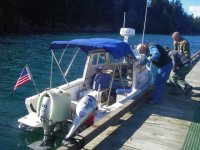
Harvey
SleepyC :moon

Then, if that doesn't work for you, Close the cabin door. Slow Down, (who needs to run at 5500 RPM?) Fast for my 40's is 4200, quiet is somewhere below 5 knots, and before there is a bow wave.
And sometimes I even play music I can hear above the 4 knot bow wave and the 1500 rpm engines.
You might try putting up a sound wall at the front of the Splash well. That worked for OG Dave on his Stretch 16.

Harvey
SleepyC :moon

T.R. Bauer
New member
People turning high 5000-6000 rpms have small outboards and are having to travel many hours to get to their destination. They might also not be retired and have a schedule. Things are pretty spread out here.
Over hull speed the plugs go in or the muffs go on in our boat. Reduces operating fatigue, protects hearing (especially that of my kids), is a good reminder that you are operating a dangerous machine, and solves acoustic issues for pennies on the dollar. Plus if you go the muffs route, you look awesome when you forget to take them off at the fuel dock. WHAT!? WHAT!? YEAH REGULAR GASOLINE THANKS!
hardee":11rrg41q said:
Hey Harvey, so that is what you actually look like? I never seen you without the beard!
Foam won’t do much to deaden the sound, let alone a single piece of sheet rock or coatings. I have had a recording studio for 20 years and the way I insulated my control room from the “live” room with drums and amps etc. was to install two walls with three pieces of varying thickness sheet rock on each with a 3 foot dead space that was airtight.
I think the on ear would be a cheaper, lighter way to go. The acoustic foam only provides a little high end frequency absorption, usually for reducing reverb on microphones.
I think the on ear would be a cheaper, lighter way to go. The acoustic foam only provides a little high end frequency absorption, usually for reducing reverb on microphones.
Smitty.io":2i1hup87 said:Foam won’t do much to deaden the sound, let alone a single piece of sheet rock or coatings. I have had a recording studio for 20 years and the way I insulated my control room from the “live” room with drums and amps etc. was to install two walls with three pieces of varying thickness sheet rock on each with a 3 foot dead space that was airtight.
I think the on ear would be a cheaper, lighter way to go. The acoustic foam only provides a little high end frequency absorption, usually for reducing reverb on microphones.
In boats the "Sound Down" type of material is used, and that has a layer of acoustic foam, then lead laced material to decouple and damp low frequencies, then a layer of thicker foam, finally Mylar material...But I would don't coat the entire interior of a boat with that.
I sold a house to a friend who did live radio broadcasts from the "office building'--we floated the floor, with foam under, also lead sheeting, than a thick carpet. The walls, had bats of fiberglass insulation in the ceiling and walls all of the way around. The inner walls, had foil, then foam, lead material, and then 4" of dimpled foam. It was as close to "silent" as I have heard.
We used the Sound Down material to sound isolate main engines on hatches, and on enclosures for the generator.
Sound Down web site.
We have used "Fish Blanket" a PVC foam for both sound and temperature lining the entire hull, then putting on the ceiling, covered with 1/8" "door skins", and a 3/32" PVC perforated hull liner material. Another boat, A friend had material left over from a high end insulating job. We put in 3/4" closed cell neoprene (Like wet suit material), and then glued a surplus sheeting from Douglas aircraft inner hull (was cabin lining for DC aircraft)
On the 22, the forward wall of the splash well is pretty low. I noticed a reduction in engine noise when I ran with my cooler hanging from the cross bar at the front of the splash well. At the time (and still am) running the Yamaha 40's (twins) that were rated as the quietest 409 on the market at the time. Between the cooler and the cabin door being closed, the OM sound was barely perceptible. (But then, my cruising speed is barely perceptible to some :lol:
Harvey
SleepyC :moon
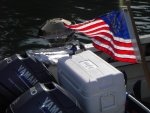
Harvey
SleepyC :moon



